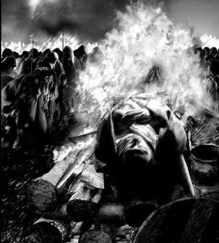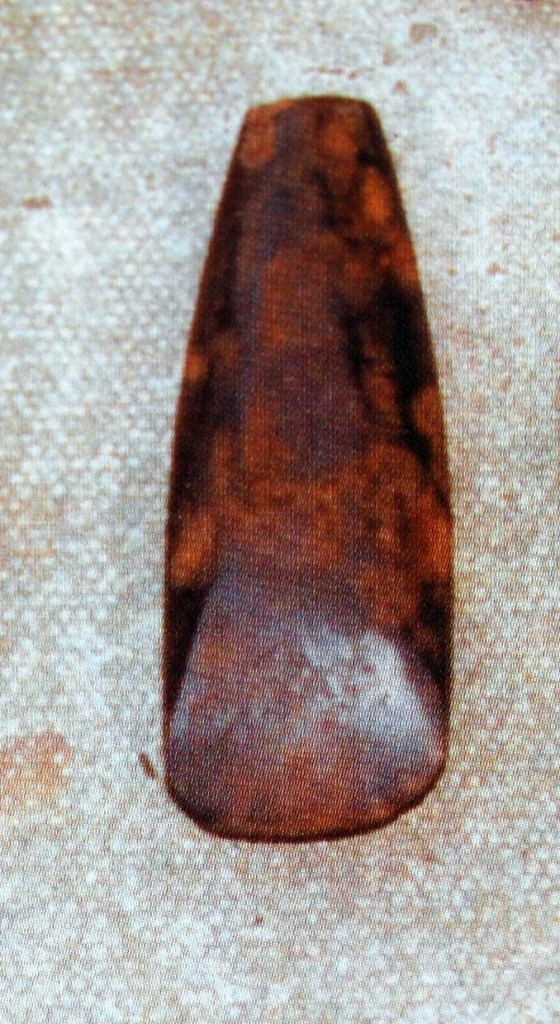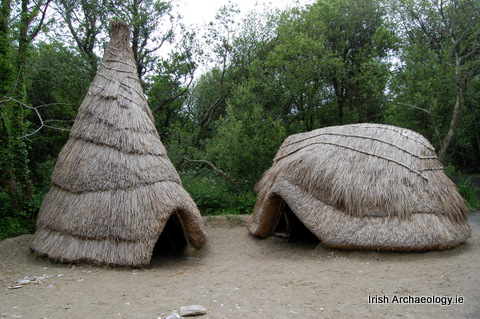
On a bend of the River Shannon, Ireland’s largest watercourse, a small band of hunter-gathers came to together nearly 9,500 years ago, to bury one of their own. At what is now known as Hermitage, Co. Limerick, they placed the remains of a man upon a large funerary pyre. It was then lit and afterwards the cremated bone was carefully gathered together and placed within a small pit, marked by a wooden post. Over the following years two more burials were added to this small cemetery and thus Ireland’s oldest-known graveyard was founded.
The earliest burial at the site was located within a sub-circular pit that measured 0.60m in diameter by 0.30m deep (Collins & Coyne 2003). The pit also contained evidence for a wooden post, approximately 0.20 m in diameter that may have represented a grave marker or some form of totem pole. The cremated remains had been carefully placed at the base of the pit in a crescent shape around the wooden post. They consisted of 1979g of burnt bone and represented the remains of an adult individual, possibly a male. The bone was efficiently cremated demonstrating that the people performing the rite were familiar with the procedure.

A large stone axe was found in association with the burial remains, along with a number of flint and chert artefacts. The axe had evidence for burning, suggesting that it had also been placed on the funerary pyre. Radiocarbon analysis of a bone fragment from the cremation returned an Early Mesolithic date of 7530-7320 BC (Collins & Coyne 2006), confirming that this was the oldest burial thus far identified in Ireland.
The second Mesolithic burial was located approximately 100m away from the first cremation. It was deposited in a much larger pit that measured 2.30m long by 1.50m wide by 0.65m deep and in this instance there was no evidence for an associated wooden post. A small deposit of cremated bone, representing an adult individual, of indeterminate gender, was found in the pit. One of the fragments of bone was radiocarbon dated to 7090-7030 BC, making this burial slightly later in date than the first one. Finds from the burial included worked and un-worked chert pieces along with burnt fish bone (Driscoll 2006). The latter possibly represents the deceased’s last meal or else a food offering that had been placed on the funerary pyre.
The human remains consisted of just 179g of bone, which is well below the expected weight of an adult cremation (c. 1,000-2,400g, after McKinley 1993, 285). This suggests that only part of the individual was deposited within the pit. This form of ‘token burial’ is characteristic of much of Irish prehistory. The reasoning behind this practice is uncertain but it is possible that part of the cremated bone was kept by the living as ancestral relics (see Brook 2006, 80) or else that selected fragments were deposited in the adjacent River Shannon. This latter option is paralleled in modern India, where some cremations burials are still deposited in the sacred waters of the River Ganges.

The final Mesolithic burial contained and even smaller amount of cremated bone. Consequently the deposit could not be conclusively identified as human and its funerary identification remains tentative. It had been placed within a large pit measuring 1.30m long by 0.70m wide by 0.50m deep and was surrounded by a charcoal rich fill. This feature was later in date than the previous two burials, with radiocarbon analysis indicating that it was interred around 6610-6370 BC.
The location of these burials on the banks of the River Shannon is not surprising, as most of the country’s Mesolithic sites have been identified in close proximity to water. This was probably because riverine and coastal locations gave access to the widest range of wild foods and also because in such a heavily wooded country, waterways would have allowed the quickest and easiest means of transport, via dug-out canoes.

The three cremations at Hermitage are extremely significant and represent an important addition to the very small corpus of Mesolithic burials from Ireland. Not alone are they the oldest burials from the country but they also demonstrate that our earliest hunter-gather ancestors practiced a relatively sophisticated means of disposing of their dead.
Related posts
Mount Sandel, a Mesolithic Campsite
References
Bruck, J. (2006) ‘Death, exchange and reproduction in the British Bronze Age’, European Journal of Archaeology, Vol.9, No. 1. 74-100
Collins T. & Coyne, F. (2003) ‘Fire and Water… Early Mesolithic Cremations at Castleconnell, Co. Limerick’, in Archaeology Ireland, Vol. 17, No. 2 (Summer 2003), Wordwell, pp. 24-27
Collins T. & Coyne, F. (2006) ‘As Old as We Felt…’Archaeology Ireland, Vol. 20, No. 4 (Winter 2006), Wordwell, p. 21
McKinley, J. I. (1993) ‘Bone fragment size and weight of bone from modern British cremations and their implications for the interpretation of archaeological cremations’, International Journal of Osteoarchaeology, Vol. 3, 283-7.
Driscoll, K. (2006) The early prehistory in the west of Ireland: Investigations into the social archaeology of the Mesolithic, west of the Shannon, Ireland.
Williams, H. (2006) Death and Memory in Early Medieval Britain. Cambridge University Press.



This is a very interesting article, and a fascinating insight in to the death rituals of our early Irish ancestors. It makes perfect sense that they resided along the coasts and rivers, since we today would do just that if we were to newly inhabit an unpopulated island. It just makes logical sense, and it’s nice to see that basic logic for survival has not changed in 10,000 years.
Cremation and burial were were a practical way of dealing with decomposing bodies. The stench of death, and infection, posed a problem which needed to be dealt with in a pragmatic manner. Ritual came later. Our ancestors were very successful survivalists who dealt with the everyday occurrences in as efficient a way as possible. It is we who assign the mystical to their actions, because it appeases our sense of propriety. It colours our hindsight with a view that may not have existed.
The current oldest graves to be found with with flowers in them are about 14,000 years old.
Ritual came a long, long time before humans made it to Ireland.
We were already physiologically modern humans, and symbol users.
You’d have a hard time finding a human culture that doesn’t assign the mystical or ceremonial to burials.
“possibly a male”.
Think about this sentence.